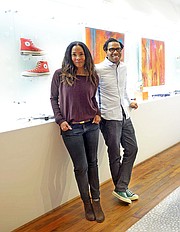RETAIL
Retailer Q&A: With Abundant Consumer Choices, Boutique Retail Blazes New Paths
Boutique retail has traditionally been a tough, creative and potentially lucrative venture, but over the past years it has been uniquely tough.
With a steady drumbeat of constant promotions from major retailers and the high degree of convenience offered by e-commerce, boutique retailers have been forced to find new ways to make their style of retail a compelling choice.
In this time of seemingly unlimited choice for consumers, three prominent Los Angeles–area boutique retailers spoke with California Apparel News about how they strive to offer the public something unique. For Ron Robinson, who founded the Ron Robinson anchor of the Fred Segal compound of stores in Los Angeles and, since November 2014, a freestanding store in Santa Monica, a new direction means creating a “daytime nightclub” at the store.
For Don Zuidema of LASC in West Hollywood, Calif., it’s about forging a strong bond with shoppers through social media and events such as the annual Gay Pride and Halloween parties. For Arlington Forbes of Canvas Malibu, an aspect of creating a unique niche has been designing in-house fashion labels for his high-end boutique in Malibu, Calif.
What are the challenges of boutique retail? What does it need to do to thrive?
RON ROBINSON: It’s more challenging every year because our customer in is tune with the global market, which offers instantaneous availability and accessibility. For better or worse, whether right or wrong, we’ve become accustomed as a society to so much more. We have to fulfill that need to a customer or be boring. If you want to move society emotionally, you’re probably going to have to do more than stand simply with a microphone on a stage. You’re going to have to have a big gig going. That’s where we are today.
In defining our retail presentation, we want the social effect of a daytime nightclub. We want a place of social community with selected, edited, curated and quality product, all of which has a certain connection and focus. Maybe the connecting thread is design.
That is where I started a couple of years ago to create and to define ourselves well beyond a boutique fashion store in the traditional sense. It’s to define fashion as a big “F,” whether that is in home design and cosmetics or men’s fashion, kids’, art gallery exhibition and floral art. All of these things are bringing energy and excitement back to boutique retailing. It is where it has got to go to survive.
The Ron Robinson boutique produces events such as weekly yoga classes and parties for the launches of fashion lines. What do other stores do?
DON ZUIDEMA: We want to make sure people see us as a store that is part of a community. The big events we do are unique. With the Gay Pride party and the Halloween parties, more than 2,000 people go to the parties on the rooftop of LASC’s building. People remember the events.
With Facebook, Instagram and other social media, we try to reach influencers in the community. What better than getting a celebrity or a trainer to say that “I shopped at LASC and I had a great time”? It is above and beyond the business model of the past. But we have to capitalize on these ways of communication.
ARLINGTON FORBES: In our opinion, the most important challenge is growing and engaging your customer base amid this new direct-to-consumer sales model. Post-recession, there has been a massive shift in the retail landscape where many retail suppliers have decided that doing business directly with the consumer would be best for their bottom line. While that may be true, the byproduct of this is that boutique retailers now find themselves in direct competition with most, if not all, of their suppliers for customer retention.
This poses an obvious challenge to boutique retailers’ ability to maintain our customer engagement. I once heard, “The Internet is like one big block and everyone is on it.” Well, now everyone is off line as well and coming to a block near you. To thrive in this environment it is important that boutique retailers choose their brands very carefully and start to see these brands as partners—partners who have a vested interest in your mutual success. This type of retailer/supplier partnership can help in many ways to create and sustain positive growth.
Another option others have utilized is the creation of their own in-house labels. Since 2012, we’ve been making Canvas Malibu [a made-in-California men’s collection with price points ranging from $205 to $245 for shirting]. It reflects the Malibu lifestyle through the lens of [co-owner] Jac [Forbes] and I through contemporary fashion. It has a unique feel and design to it. By making our in-house line, it keeps our clients coming back. They can only buy it here.
What can civic and business leaders do to make it easier for boutique retail to thrive?
AF: If they came together to assist retail in a similar fashion to what they have done to support the film/television industry in Los Angeles—a healthy program of tax-reduction incentives—things would be better. Retail now has Small Business Day, which is great for awareness, but why can that day not be coupled with a tax-free shopping day? In other cities tax-free days have done well to drive customers into shops, and it allows boutique shops to offer a discount that does not chip into their already small margins. In other states across the country, certain clothing purchases below a particular dollar value (i.e., $100) are tax exempt. Also, boutique businesses that produce their in-house labels in LA should be incentivized through tax reductions to do so. These are just a few ideas that have proven successful in other cities and states. Why not LA?
RR: In Los Angeles, we can make it easier to get around. We can make transit much easier. Then you can get from one place to the next in a reasonable time frame. I found a unique support system in the city of Santa Monica. The Santa Monica Travel & Tourism bureau has been extremely supportive by exposing all of the businesses to the travelers and tourists through the hotels. It’s through newsletters. The newsletters also let all of the [hotel] concierges know about city businesses. Those things are helpful on a networking basis. The City of Santa Monica also has uniformed ambassadors on the streets. They have people who are just walking around [the downtown area] and can answer questions for you. The ambassadors have visited our store, become familiar with it and are directing people to our store.
























